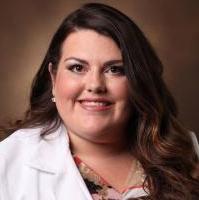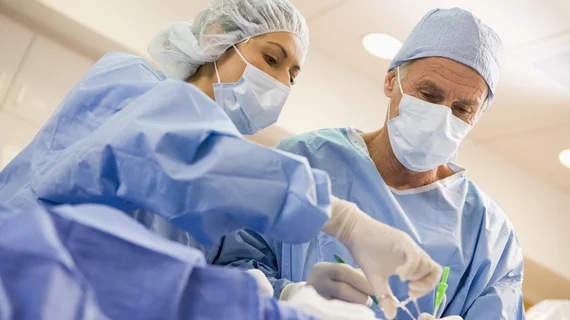‘Making good, better’: Next-gen TAVR techniques and protocols optimize patient care, boost efficiency
Innovation in the transcatheter aortic valve replacement (TAVR) space has upped the ante once again. Refined techniques for implanting self-expanding valves, new TAVR care pathways and treatment protocols have brought about better patient outcomes, a halving of pacemaker rates and next-day discharges as most patients skip general anesthesia, intubation and the ICU.
“We’re making good, better,” says Kendra Grubb, MD, MHA, co-principal investigator of the OPTIMIZE PRO clinical study and surgical director of the Structural Heart and Valve Center for Emory Healthcare in Atlanta.
“It’s exciting because we offer something to our patients that is reliable, low risk and allows many of them to go home the next day. We needed to fine-tune the techniques and protocols. We’re truly optimizing the patient experience and are giving them the best result.”

Co-principal investigator of the OPTIMIZE PRO clinical study and surgical director of the Structural Heart and Valve Center for Emory Healthcare
In TAVR’s early days, physicians strived to understand how to get the valve to stay in the annulus. “Now, the industry has given us much better devices and solved a lot of the problems we had early on,” she says. “That helps us put the valve where it works best. But the bar also is set really high. When you have to compare your results with surgery—which has a 50-year track record—you need to fine-tune your techniques and protocols to give patients excellent outcomes.”
Sara Negrotto, MD, an interventional cardiologist for Covenant Health in Knoxville, Tenn., favors the new techniques and protocols as well. “These changes have allowed us to do minimalist TAVR in a real-world setting,” she notes. “We use conscious sedation on most patients as well as transthoracic echocardiography, and we’re no longer leaving pacemakers in overnight for everyone getting an Evolut [Medtronic]. Our pacemaker rates have been consistent with the recent studies which has allowed patients to leave the hospital earlier, usually the next day. This advancement is great for both the patient and our health system.”
Signs of that meticulous fine-tuning and lower complication rates can be found in the success clinicians have had with Medtronic’s Evolut R, PRO and Evolut PRO+ self-expanding transcatheter aortic valves (TAVs). These next-generation systems have performed well in both academic and community care settings, suggesting that the future of aortic valve replacements is no longer the future at all—it’s the present.
A real-world look at the platform in action
Heart teams have been implanting the Evolut PRO for more than four years now, and the Evolut PRO+ for nearly two, providing the industry with a healthy dose of data on the platform’s safety and effectiveness. Recent data shows how far TAVR with self-expanding valves has come.
In May, Grubb presented 30-day findings from the OPTIMIZE PRO trial at the Society for Cardiovascular Angiography & Interventions 2021 Scientific Sessions. The study, a postmarket analysis of 171 patients treated with Evolut PRO or Evolut PRO+, found that the devices were associated with mortality and disabling stroke rates of 0%, a permanent pacemaker implantation (PPI) rate of 8.8% and a median length of stay of only one day.
While the PPI rates are good, Grubb expects they’ll drop further to about 5% as TAVR teams grow more comfortable with the cusp overlap technique. The current rate for all-comers (Evolut PRO and PRO+) at Emory where Grubb practices is 4%.
From their interim analysis, OPTIMIZE PRO investigators hypothesize they had been too aggressive in the past with putting in pacemakers after TAVR, as most conduction abnormalities resolve within 30 days. “That is so important,” Grubb says, “because really good data shows us that patients who end up with a pacemaker after TAVR or cardiac surgery have lower long-term survival. So if we can avoid it, the patients do better.”
More extensive data from the STS/ACC TVT Registry was presented weeks later, during the American College of Cardiology’s 2021 annual meeting. James E. Harvey, MD, an interventional cardiologist at WellSpan Cardiology in York, Pa., shared the analysis of more than 46,000 patients who received an Evolut TAVR system. Harvey reported a device success rate of 97.2%, a PPI rate of 8.5% and, again, a median length of stay of just one day.
As he described, the temporal reductions in PPI seen across the TVT Registry data resulted from the introduction of new TAVR care pathways, switching to the cusp overlap technique, changing thresholds for PPI implantation and post-TAVR home monitoring of conduction abnormalities.
Negrotto says the results of both studies reflect her own experience with the valves. New techniques have made self-expanding valves “much more competitive with the balloon expandable valves. Ideally, we want patients to be able to discharge the next day after TAVR and with decreased pacemaker rates, that can happen.”
New technique a home run with clinicians
One of the primary drivers of the Evolut platform’s recent success is the cusp overlap technique, a simplified implantation method that isolates the patient’s non-coronary cusp to give clinicians a more complete understanding of TAVR placement. Grubb says the new technique, along with a prespecified conduction disturbance pathway, are exactly the kind of upgrades that separates these self-expanding valves from the rest of the pack; Medtronic made significant improvements without completely starting over from scratch.
“We didn’t need a whole new valve design,” Grubb says. “We needed a better way to implant. Cusp overlap is a subtle change, but it allows the implanters to gain a better view of the lowest point in the annulus and stay well above the conduction tissue. This has helped update the way clinicians think about these valves; our target depth used to be 5 or 6 mm, but now it’s 3 mm.”
Negrotto calls cusp overlap a “game-changer” for TAVR patients, especially when it comes to reducing PPI rates. Other aortic valves have been associated with PPI rates as high as 20%, making it one of the biggest concerns clinicians had about using these devices. But the reliable view and improved valve deployment that comes with cusp overlap may have finally reversed that trend for good.

Interventional cardiologist, Covenant Health
“Cusp overlap helps with those patients who are at a higher risk for a pacemaker. For example, if someone had a pre-existing right bundle branch block, it was almost guaranteed he or she would need a pacemaker with the Evolut platform. However, since using cusp overlap, we have had several patients with right bundle branch blocks who did not need one.”
As Grubb adds, with historically high PPI rates for self-expanding valves, “there can be a knee-jerk reaction by the implant team to just in a pacemaker and move on.” Adapting the Evolut platform, and the cusp overlap technique, is helping heart teams see that the PPI rates can be lower—and patient management is a crucial part of that equation.
“If a patient has a new conduction abnormality after TAVR, do they really need a pacemaker immediately?” Grubb questions. “Or can we safely observe the patient and see how the heart responds? These techniques are helping us changing the mindset of implant teams so that we can truly optimize the patient experience.”
There will always be times when a pacemaker is necessary. But showing clinicians that rates much lower than 20% are not only possible, but expected, stands as a huge step forward for cardiac care.
Programs do need to consider the early learning curve, Grubb notes. The OPTIMIZE PRO data showed that 70% of sites placed no pacemakers, while only a few outliers accounted for 60% of the pacemakers placed in the entire trial.
“But this technique is very teachable and reproducible,” she adds. “That’s one of the best parts about it. It is simple and straightforward. It’s a recipe and when you follow it you get a good result. It takes most teams just a few procedures to get comfortable.”
Winning the battle against paravalvular regurgitation
Another key improvement with the Evolut PRO platform is the high sealing wrap that limits paravalvular regurgitation.
Significant paravalvular regurgitation after TAVR increases mortality and can increase morbidity, as Negrotto points out. “When you have significant paravalvular regurgitation after TAVR, patients do not feel better as you have exchanged one problem for another. The high wrap on the [Evolut] PRO+ helps reduce the incidence and severity of perivalvular regurgitation.”
Paravalvular regurgitation can lead to heart failure symptoms over time, she adds, and it can cause the left ventricle to dilate.
The OPTIMIZE PRO trial offered evidence that the wrap is making an immediate impact. Grubb reports that OPTIMIZE PRO demonstrated early excellent PVL performance with 80% of TAVR patients having either trace perivalvular regurgitation or none at all. Negrotto says her team’s results are consistent with those results.
Proving grounds for TAVR
As clinicians continue to see promising results with the Evolut platform and cusp overlap technique, it helps give additional credence to the thought that TAVR and SAVR could be viewed as equals for the treatment of aortic stenosis. Perhaps, Grubb notes, TAVR will prove to be a flat-out superior treatment for certain patient populations.
The use of a self-expanding valves can be important in patients with significant LVOT calcium, small aortic annulus or those with prior surgical aortic valve replacement (SAVR) in need of TAV in SAV.
The next step, it seems, is to wait and see.
“With recent changes to the guidelines for patients 65 to 80, we’re trying to optimize our technique to achieve the same or better outcomes as surgery,” she says. Yet, “none of these devices have been around long enough to accurately assess their durability in patients younger than 65 years old. So we’ll be following our young low-risk patients for 10+ years. We still have a tremendous amount to learn about these valves.”
While the learning continues, more patients are benefitting. “We are able to treat more patients safely with better outcomes,” Negrotto says. “Previously, studies have shown higher pacemaker rates and more significant perivalvular regurgitation when comparing TAVR vs. SAVR. However, as technology and implant techniques improve, we may be able to decrease the margin and have the opportunity to treat patients that would not have been treated in the past. TAVR continues to gain momentum and patients are asking about the therapy. It is monumental when you can deliver a therapy in a safer manner with fewer complications.”
Michael Walter is the editor and digital strategist of CardiovascularBusiness.com.
For more information on the Evolut™ TAVR portfolio and important safety information visit: https://www.medtronic.com/us-en/healthcare-professionals/therapies-procedures/cardiovascular/transcatheter-aortic-valve-replacement.htm

